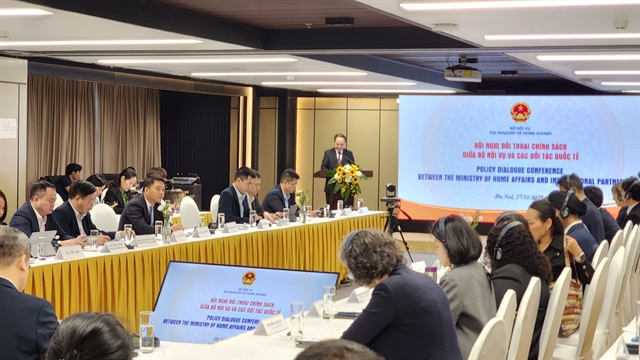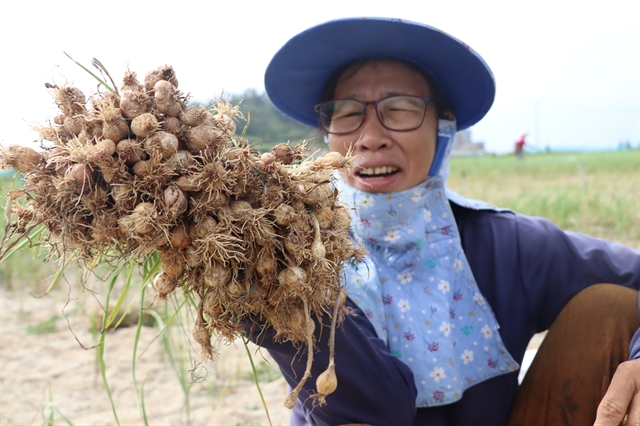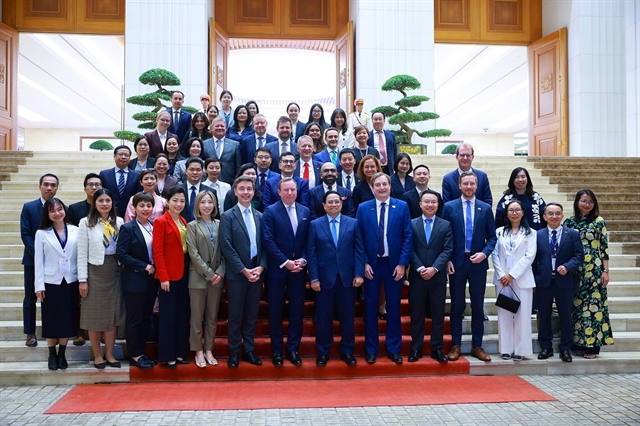 Society
Society

 |
| A farmer shows a poor-quality garlic crop on her farm in Lý Sơn Islands, off Quảng Ngãi Province's coast. The islands' had an 80 per cent loss at the 2022-23 Winner-Spring crop. — Photo courtesy of Hữu Danh |
LÝ SƠN — Farmers on the Lý Sơn Islands have experienced a significant decline in their 2022-23 Winter-Spring garlic crops, with only 120 tonnes, or roughly 80 per cent of a bumper harvest, collected by the end of February.
According to Phạm Thị Hương, chairwoman of the district's People's Committee, uninterrupted rains and cold spells during the sowing period in late winter are thought to be the primary reasons for the crop's poor growth.
This is the second consecutive year in which the islands' garlic crop has suffered a decline in productivity. In the previous year's 2021-22 harvest, only 1,200 tonnes, a 30 per cent decrease, were produced on a total of 320 hectares of farmland.
Garlic cloves were either rotten or dormant due to heavy rainfall and cold weather between November and December.
Poor-quality garlic resulted in a lower price, as a kilo of dried garlic was sold at VNĐ10,000 (US$0.40) or VNĐ15,000 ($0.60) – a 75 per cent reduction compared to a good price ranging from VNĐ40,000 ($1.60) to VNĐ70,000 ($2.80).
Nguyễn Thị Kiểm, a farmer, said she invested VNĐ45 million for her family's 1,500sq.m plot, but only 700kg of garlic was collected.
Also growing on a 2,000sq.m farm in An Vĩnh Commune, Lê Thị Lộc even picked 100kg of dormant roots that were sold for around 40 US cents per kilo.
She said that in the previous crop, her farm yielded two tonnes, generating revenue of VNĐ90 million, but she suffered a heavy loss after the new year.
In recent years, garlic planting farmers on the islands, which are 30km off the coast of central Quảng Ngãi Province, has been facing the risk of crop loss due to climate change and saline underground water in the dry season.
The islands have been seeking adaptive climate change crops to ease the loss for local farmers, including pea and maize and organic production.
Phạm Văn Công, director of the Lý Sơn Islands-based DORI Joint Stock Company, said that organically grown crops are seen as a sustainable farming solution on the islands. However, farmers are still hesitant to begin, as they prefer chemical fertilisers and pesticides for their crops.
They are still hesitant to transition from traditional agricultural practices to organic farming, fearing low productivity, high production costs, and an unstable market, Công said.
He said that only ten farmers have been working on a 3ha organic garlic farm since 2016, while organic garlic and purple onion farms occupy less than 1 per cent of the islands' total farmland.
The islands' committee reported that local farmers use around 40 tonnes of chemical fertiliser for every garlic crop and waste VNĐ20 billion on cleaning the chemically contaminated farm soil.
The district's committee has encouraged local farmers to use bio-fertiliser and bio-pesticide on 100ha of safe farms.
The islands' garlic and purple scallion earned Geographical Indication (GI) status from 2019, while the brand ownership for the products of Lý Sơn Island, including garlic, purple scallion, seafood, and seaweed, was recognised by the National Office of Intellectual Property of Việt Nam, under the Ministry of Science and Technology, for 100 households and individuals on the islands from 2007.
It has been building as a "zero" carbon and eco-tourism islands, promoting renewable energy such as solar and wind power. — VNS




